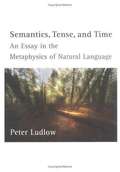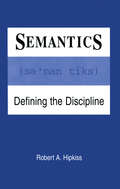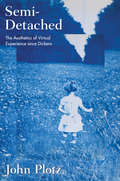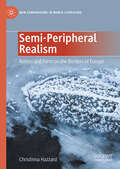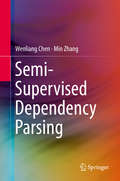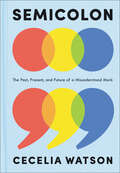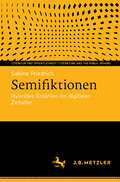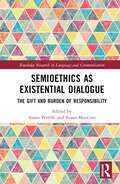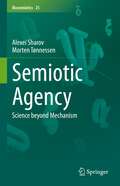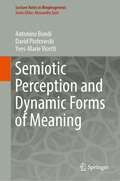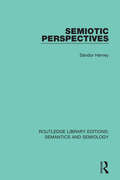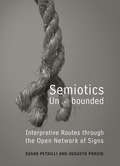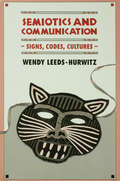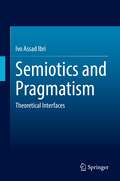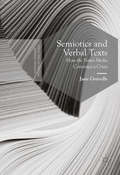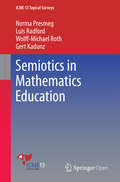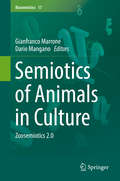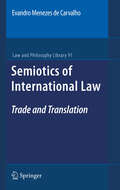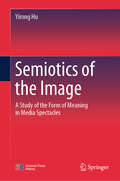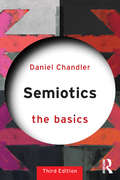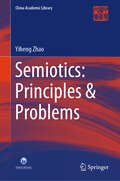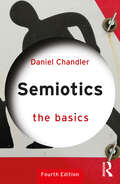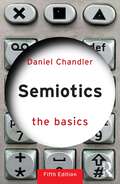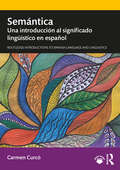- Table View
- List View
Semantics, Tense, and Time: An Essay in the Metaphysics of Natural Language
by Peter LudlowOne of the central goals of this book is to illustrate how one can study metaphysical questions from a linguistic/semantical perspective. The specific issue that the author has chosen to investigate is the well-entrenched dispute between A-theorists and B-theorists about the nature of time.
Semantics: Defining the Discipline
by Robert A. HipkissThe subject of semantics has been appropriated by various disciplines including linguistic philosophy, logic, cognitive psychology, anthropological linguistics, and computer technology. As a result, it is difficult to define the study of semantics as an actual discipline without discovering what each field using a semantic approach to its subject matter has contributed to the understanding of what words mean. This volume is a result of those discoveries. Primarily an introductory work, this volume outlines the approaches that various disciplines have taken to the subject, attempts to show their relationships and their limitations, and presents the more important aspects of each approach -- from psychosemantics to artificial intelligence -- using pertinent source material from psychology, philosophy, logic, linguistics, and sociology. For individuals coming to the study of semantics for the first time, or those who are interested in what the overall study may offer beyond their specialization, this volume will provide a helpful overview of the subject.
Semantisch-konzeptuelle Vernetzungen im bilingualen mentalen Lexikon: Eine psycholinguistische Studie mit deutsch-türkischsprachigen Jugendlichen (Linguistik in Empirie und Theorie/Empirical and Theoretical Linguistics)
by Sebastian VeletićDas bilinguale mentale Lexikon weist eine komplexe netzwerkartige Struktur auf, die in diesem Buch theoretisch ergründet und empirisch untersucht wird. Sebastian Veletić diskutiert prominente Modelle des bilingualen mentalen Lexikons und entwirft auf der Grundlage eines deutsch-türkischen Bildbenennexperiments ein Modell des bilingualen mentalen Lexikons deutsch-türkischsprachiger Jugendlicher. Das Modell zeigt, wie deutsche und türkische Lexikoneinträge semantisch-konzeptuell miteinander vernetzt sind.
Semi-Detached: The Aesthetics of Virtual Experience since Dickens
by John PlotzWhen you are half lost in a work of art, what happens to the half left behind? Semi-Detached delves into this state of being: what it means to be within and without our social and physical milieu, at once interacting and drifting away, and how it affects our ideas about aesthetics. The allure of many modern aesthetic experiences, this book argues, is that artworks trigger and provide ways to make sense of this oscillating, in-between place. John Plotz focuses on Victorian and early modernist writers and artists who understood their work as tapping into, amplifying, or giving shape to a suspended duality of experience.The book begins with the decline of the romantic tale, the rise of realism, and John Stuart Mill’s ideas about social interaction and subjective perception. Plotz examines Pre-Raphaelite paintings that take semi-detached states of attention as their subject and novels that treat provincial subjects as simultaneously peripheral and central. He discusses how realist writers such as Charles Dickens, George Eliot, and Henry James show how consciousness can be in more than one place at a time; how the work of William Morris demonstrates the shifting forms of semi-detachment in print and visual media; and how Willa Cather created a form of modernism that connected aesthetic dreaming and reality. Plotz concludes with a look at early cinema and the works of Buster Keaton, who found remarkable ways to portray semi-detachment on screen.In a time of cyberdependency and virtual worlds, when it seems that attention to everyday reality is stretching thin, Semi-Detached takes a historical and critical look at the halfway-thereness that audiences have long comprehended and embraced in their aesthetic encounters.
Semi-Peripheral Realism: Nation and Form on the Borders of Europe (New Comparisons in World Literature)
by Christinna HazzardThis book explores the geopolitical and symbolic borders of Europe through the concept of the semi-periphery. Focusing on the North Atlantic island nations, Iceland and the Faroe Islands, and Turkey – a set of very different social and cultural landscapes – the book compares the semi-peripheral aesthetics of Halldór Laxness’s and William Heinesen’s novels with the semi-peripheral city and borderscapes in works by Orhan Pamuk and Latife Tekin. It offers new readings of texts such as Laxness’s The Atom Station and Pamuk’s Snow, and provides original readings of works that little has been written about in English, such as Heinesen’s The Black Cauldron and Tekin’s Swords of Ice. Making use of the theory of uneven and combined development and world systems theory, the book illustrates that the experience of nation-building and capitalist modernisation in the semi-periphery results in a particular realist aesthetic that is remarkably similar across different regional literatures. The book’s world-literary method shows that the semi-periphery constitutes a vital and productive area of study both for world literature and for broadening our understanding of colonialism and imperialism on the margins of continental Europe.
Semi-Supervised Dependency Parsing
by Min Zhang Wenliang ChenThis book presents a comprehensive overview of semi-supervised approaches to dependency parsing. Having become increasingly popular in recent years, one of the main reasons for their success is that they can make use of large unlabeled data together with relatively small labeled data and have shown their advantages in the context of dependency parsing for many languages. Various semi-supervised dependency parsing approaches have been proposed in recent works which utilize different types of information gleaned from unlabeled data. The book offers readers a comprehensive introduction to these approaches, making it ideally suited as a textbook for advanced undergraduate and graduate students and researchers in the fields of syntactic parsing and natural language processing.
Semicolon: The Past, Present, and Future of a Misunderstood Mark
by Cecelia Watson“Delightful, enlightening . . . The twisty history of the hybrid divider perfectly embodies the transience of language.” —VultureThe semicolon. Stephen King, Hemingway, Vonnegut, and Orwell detest it. Herman Melville, Henry James, and Rebecca Solnit love it. But why? When is it effective? Have we been misusing it? Should we even care?In Semicolon, Cecelia Watson charts the rise and fall of this infamous punctuation mark, which for years was the trendiest one in the world of letters. But in the nineteenth century, as grammar books became all the rage, the rules of how we use language became both stricter and more confusing, with the semicolon a prime victim. Taking us on a breezy journey through a range of examples—from Milton’s manuscripts to Martin Luther King Jr.’s “Letters from Birmingham Jail” to Raymond Chandler’s The Big Sleep—Watson reveals how traditional grammar rules make us less successful at communicating with each other than we’d think. Even the most die-hard grammar fanatics would be better served by tossing the rule books and learning a better way to engage with language.Through her rollicking biography of the semicolon, Watson writes a guide to grammar that explains why we don’t need guides at all, and refocuses our attention on the deepest, most primary value of language: true communication.“What? Sit on the beach reading about punctuation? Yes, when it’s as fun, rangy, and witty as this.” —The Philadelphia Inquirer, “Big Summer Books”“A scholarly treatise on a sophisticated device that has contributed eloquence and mystery to Western civilization . . . Delightful.” —The New Yorker
Semifiktionen: Hybrides Erzählen im digitalen Zeitalter (Literatur und Öffentlichkeit / Literature and the Public Sphere)
by Sabine FriedrichSeit einiger Zeit erleben semifiktionale Erzählungen in Weblogs, der Twitteratur und weiteren Erzählformaten in den sozialen Medien sowie in historisch-fiktionalen Texten und Filmen eine starke Konjunktur. Der Reiz, die Potentiale, aber zugleich auch die Risiken der Hybridformate bestehen darin, dass die Grenzen zwischen dem Bereich des Fiktionalen und des Faktualen häufig unscharf bzw. überhaupt nicht markiert sind. Anhand eines breiten Spektrums semifiktionaler Erzählungen untersucht die Studie die Strukturen der Hybridformate und fragt nach ihrer Verankerung in unserer gegenwärtigen Kultur – vor allem in Zeiten digitaler Kommunikation. Welche kulturellen Funktionen übernehmen die Semifiktionen angesichts der Vielstimmigkeit der zirkulierenden Wirklichkeitsnarrative? Zugleich stellt sich die grundsätzliche Frage, welche Konzeptionen von Fiktionalität sich hieraus für die heutige Zeit ergeben.
Semioethics as Existential Dialogue: The Gift and Burden of Responsibility (Routledge Research in Language and Communication)
by Susan Petrilli Susan MancinoThis collection brings together perspectives on the interplay of communication, dialogue, and responsibility, exploring communicative acts of disruption toward a social environment attuned to short-sighted individualism. Semioethics highlights the condition of inevitable entanglement with the other at the origin of sociality, which demands a response to the other based on listening and accountability.The volume introduces readers to the theoretical foundations of semioethics, an emergent direction within sign and language studies which relies upon a commitment to otherness, unindifference, and dialogue. Building on the dialogic approaches of Mikhail Bakhtin and Emmanuel Levinas, chapters, grouped into five sections, are all guided by the notion of responsibility toward the other outside do ut des logic and greedy exchange. This collection highlights the ways in which semioethics considers the ethical implications of the signs that mediate dialogue among persons in the social sphere, public and private, sacred and profane. It presupposes the notion that signs are only meaningful in their relation to other signs and the intersubjectivity among persons in dialogue. Chapters also variously examine how the interplay of semioethics and dialogue underpins public life and the existential gifts that sustain a healthy polis.This book will be of interest to scholars in semiotics, dialogue research, communication ethics, and philosophy of communication.
Semiotic Agency: Science beyond Mechanism (Biosemiotics #25)
by Alexei Sharov Morten TønnessenThis book invites readers to embark on a journey into the world of agency encompassing humans, other organisms, cells, intracellular molecular agents, colonies, populations, ecological systems, and artificial autonomous systems. We combine mechanistic and non-mechanistic approaches in the analysis of the function and evolution of organisms, their subagents, and multi-organism systems, and in this way offer a theoretical platform for integrating biosemiotics with both natural science and the humanities/social sciences. Agents are autonomous systems that incorporate knowledge on how to make sense of their environment and use it to achieve their goals. The functions of all agents are supported by mechanisms at the lowest level; however, the explanatory power of mechanistic analysis is not sufficient for complex agents. Non-mechanistic methods rely on the goal-directedness of agents whose dynamics follow self-stabilized dynamic attractors. The properties of attractors depend on stable or slowly changing factors, and such dependencies can be interpreted as sign relations if they are adaptive in nature. Agents can replace or redirect mechanisms on demand in order to preserve their functions; for performing higher-level semiotic functions, mechanisms are thus only means. We assume that mechanism and semiosis are not mutually exclusive, and that simple agents can interpret signs mechanistically. This assumption allows us to extend semiotic analysis to all agents, including ribosomes in cells, computers, and robots. This book challenges established traditions in natural science and the humanities/social sciences: semiotics no longer appears as restricted to humans and rational thinking, and biology is no longer limited to rely exclusively on mechanistic reasoning.
Semiotic Perception and Dynamic Forms of Meaning (Lecture Notes in Morphogenesis)
by David Piotrowski Antonino Bondi Yves-Marie VisettiWhat do we mean by semiotic perception? Why should the concepts of perception and expressivity be reinterpreted within the encompassing framework of a dynamic theory of semiotic fields and forms? Can we redeploy the concept of form in such a way as to make explicit such a native solidarity (‘chiasmatic’ would have said Merleau-Ponty) between perception, praxis and expression -- and first and foremost in the activity of language, right to the heart of the life of the social and speaking animal that we are? What then would be the epistemological and ontological consequences, and how might this affect the way we describe semiolinguistic forms? This book aims to provide answers to these questions by opening up avenues of research on how to understand the linguistic and semiotic dimensions at work in the constitution of experience, both individual and collective.
Semiotic Perspectives (Routledge Library Editions: Semantics and Semiology)
by Sándor HerveyFirst published in 1982, this book looks at a wide variety of issues concerning the vast field of study that is ‘semiotics. It begins by tracing the beginnings of modern semiotics in the works two pioneering figures — Saussure and Peirce — in order to present fundamental assumptions, notions and distinctions which provide an essential background to the more recent developments. The author then goes on to look at Behavioural Semiotics, Luis Prieto’s idea of "l’Acte Semique", Austin’s theory of ‘Speech Acts’ and Searle’s elaborations, Barthes’ move away from philosophical and scientific approaches in his ideology of Socio-Cultural Signification, Functionalism and Axiomatic Functionalism, style as a form of communication, semiotics of the cinema, and communicative behaviour in non-human species.
Semiotics Unbounded
by Augusto Ponzio Susan PetrilliThe more human knowledge increases, the more signs grow and, with this expansion, the more the boundaries of the science that studies signs also grows. In Semiotics Unbounded, Susan Petrilli and Augusto Ponzio explain the explosion of the sign network in the era of global communication and discuss the important theoretical responses offered by semiotics. Providing a much-needed introductory guide to the subject, Petrilli and Ponzio explore the ever-growing frontiers of semiotics through the thought of prominent sign scholars such as Charles Peirce, Victoria Welby, Mikhail Bakhtin, Charles Morris, and Thomas Sebeok.In an era of global communication, a global approach is necessary, and what may seem to be the whole, is only a part - a view being at once globalizing and open. Each and every sign is never self-sufficient and closed but exists always in a relation of otherness. This is true of the signs forming animals and human beings, individuals and communities, and involves the implication of all living beings in the life of all others. Semiotics Unbounded offers a new and original survey of the science of signs, evaluating it in relation to the problems of our time, not only of a scientific order, but also the problems concerning everyday social life.
Semiotics and Communication: Signs, Codes, Cultures (Routledge Communication Ser.)
by Wendy Leeds-HurwitzCommunication is, among other things, about the study of meaning -- how people convey ideas for themselves and to one another in their daily lives. Designed to close the gap between what we are able to do as social actors and what we are able to describe as social analysts, this book introduces the language of semiotics -- a language that provides
Semiotics and Pragmatism: Theoretical Interfaces
by Ivo Assad IbriThis collection of essays brings together a selection of some of the most important studies of Professor Ivo Assad Ibri about the work of Charles Sanders Peirce. In the last decades, Prof. Ibri made important contributions to Peirce studies by showing that the various individual aspects of Peirce’s work actually form a coherent philosophical system, a metaphysical architecture, as he describes it in his previous book Kósmos Noetós (Springer, 2017). Now this new book brings together a selection of 24 articles and book chapters originally published in both Portuguese and English on different topics and aspects of Peirce’s work, such as philosophy of art, heuristic logic, theories of beliefs and habits, objective idealism, pragmatism and pragmaticism. By bringing together this collection of essays in a single publication, Semiotics and Pragmatism: Theoretical Interfaces will be a valuable source for scholars interested in Prof. Ibri’s unique contributions to the study of the philosophy of Charles Sanders Peirce. “In recognizing Ivo Assad Ibri as one the leading exponents of qualitative interpretations of Peirce in the world today, I refer especially to Ibri’s concentration on Peirce’s later-phase metaphysical writings. Ibri’s expertise will be seen to consist in his precise reformulations of Peirce’s full-fledged philosophy, not just pursuing specialized minor topics.” David A. Dilworth Professor of Philosophy, Stonybrook University “Ivo Ibri’s collected essays brims with clarifying insights from beginning to end. He manages to reveal plenty of aspects of Peirce’s thought from angles the traditional scholarship has not been equipped to notice. How not to miss such kairotic theoretical opportunities and how to exploit them to heuristic advantage is a lesson well taught in this outstanding book.” André De Tienne Professor of Philosophy and Director of the Peirce Edition Project, Indiana University
Semiotics and Verbal Texts
by Jane GravellsThis book offers an innovative approach to analysing written texts, grounded in principles of semiotics. Envisaging whole news media representations as 'signs', and using the real-world example of the BP Deepwater Horizon crisis, the author demonstrates how business crises are constructed through language. Gravells identifies patterns of language which show a progression from one kind of 'current news' representation to a different kind of coverage. This coverage positions the crisis as having symbolic and conventional meaning within varied social contexts, including the arts, business and the environment. Using a wealth of examples from the BP story to illustrate her practical research approach, Gravells draws 'language maps' of different phases of the crisis representation, showing how an early 'iconic' phase of representation moves through an 'indexical' to a 'symbolic' phase, and projects a return to a 'naturalised icon'. This book will be of interest to researchers and students of semiotics, those exploring research methods and linguists with an interest in business and media communications.
Semiotics in Mathematics Education
by Wolff-Michael Roth Norma Presmeg Luis Radford Gert KadunzThis volume discusses semiotics in mathematics education as an activity with a formal sign system, in which each sign represents something else. Theories presented by Saussure, Peirce, Vygotsky and other writers on semiotics are summarized in their relevance to the teaching and learning of mathematics. The significance of signs for mathematics education lies in their ubiquitous use in every branch of mathematics. Such use involves seeing the general in the particular, a process that is not always clear to learners. Therefore, in several traditional frameworks, semiotics has the potential to serve as a powerful conceptual lens in investigating diverse topics in mathematics education research. Topics that are implicated include (but are not limited to): the birth of signs; embodiment, gestures and artifacts; segmentation and communicative fields; cultural mediation; social semiotics; linguistic theories; chains of signification; semiotic bundles; relationships among various sign systems; intersubjectivity; diagrammatic and inferential reasoning; and semiotics as the focus of innovative learning and teaching materials.
Semiotics of Animals in Culture: Zoosemiotics 2. 0 (Biosemiotics Ser. #17)
by Gianfranco Marrone Dario ManganoTo place animals within the realm of nature, means inserting them among the articulations of culture and the social. Semiotics has never avoided this chiasmus, choosing to deal from the outset with the problem of the languages of animals following the old admonition of Montaigne: it is not that animals do not talk, it is us who do not understand them.Recent research in the field of the anthropology of nature and sociology of sciences and techniques allow to think about the Zoosemiotic issue in a different way. Instead of transplanting the language structures – gestures, LIS, etc. – for a semiotic study of the forms of the human and social meaning, it seems more apt to look at their discourse, and as such, the actual interactions, communicative and scientific as well as practical and functional, between humans and non-humans. This book aims to investigate precisely this hypothesis, known here as Zoosemiotics 2.0, working on several fronts and levels:· Anthropology· Languages of the image and visual representations, from art history to cinema· Old and new media. From literature to comics, from cartoons to TV documentaries but also advertising, music, Web and social networks. All those cultural products that talk about the role of human and non-human in society implicitly proposing (and in some way imposing) a form of articulation of such a relationship.· Food and feeding rites· Animalist, vegetarian and vegan movements · Philosophy: metaphysics, ethics, aesthetics
Semiotics of International Law
by Evandro Menezes de CarvalhoLanguage carries more than meanings; language conveys a means of conceiving the world. In this sense, national legal systems expressed through national languages organize the Law based on their own understanding of reality. International Law becomes, in this context, the meeting point where different legal cultures and different views of world intersect. The diversity of languages and legal systems can enrich the possibilities of understanding and developing international law, but it can also represent an instability and unsafety factor to the international scenario. This multilegal-system and multilingual scenario adds to the complexity of international law and poses new challenges. One of them is legal translation, which is a field of knowledge and professional skill that has not been the subject of theoretical thinking on the part of legal scholars. How to negotiate, draft or interpret an international treaty that mirrors what the parties, - who belong to different legal cultures and who, on many occasions, speak different mother tongues - ,want or wanted to say? By analyzing the decision-making process and the legal discourse adopted by the WTO's Appellate Body, this book highlights the active role of language in diplomatic negotiations and in interpreting international law. In addition, it also shows that the debate on the effectiveness and legitimacy of International Law cannot be separated from the linguistic issue.
Semiotics of the Image: A Study of the Form of Meaning in Media Spectacles
by Yirong HuThis book provides a groundbreaking exploration of image semiotics. Going far beyond traditional analyses of static visual texts, it includes dynamic imagery, literary iconography, and psychological images, offering a holistic view of how semiotics permeates various forms of media and cultural expression. The book integrates various case studies on Chinese culture, providing scholars outside China a unique lens through which to understand Chinese cultural thinking through semiotics. This approach not only enriches the academic discussion but also enhances cross-cultural understanding. In addition, the book collects and synthesizes significant achievements in semiotics, incorporating traditional visual theory research from the Panofsky and Warburg schools. This synthesis forms a comprehensive “semiotics of images,” providing an interdisciplinary analytical framework for contemporary “media spectacles.” The book employs multiple methodologies to dissect the visual image spectacles constructed by modern media signs, culminating in a macro-level understanding of cultural spectacles. Furthermore, it situates the comparison between Chinese and Western civilizations within a broad context of cultural philosophy and history, enriching the discourse on cultural differences and similarities.
Semiotics the Basics: The Basics (The Basics)
by Daniel ChandlerThis updated second edition provides a clear and concise introduction to the key concepts of semiotics in accessible and jargon-free language. With a revised introduction and glossary, extended index and suggestions for further reading, this new edition provides an increased number of examples including computer and mobile phone technology, television commercials and the web. Demystifying what is a complex, highly interdisciplinary field, key questions covered include: What is a sign? Which codes do we take for granted? How can semiotics be used in textual analysis? What is a text? A highly useful, must-have resource, Semiotics: The Basics is the ideal introductory text for those studying this growing area.
Semiotics: Principles & Problems (China Academic Library)
by Yiheng ZhaoThis book attempts to build semiotics on a new foundation, which is “meaning-making”. At the very beginning, the central terms of signs and semiotics are redefined, as the old definition for sign (one thing standing for another) is far from satisfactory. Sign is a perception that is regarded as carrying meaning. In this way, semiotics, now built on the foundation of meaning-making and meaning-cognition, is a science of meaning. All the principles are now under the scrutiny of the new definition, and many issues are answered more succinctly. Therefore, the new definition is extended to the new fields of cultural activities in human society, and a series of problems arise. This book intends to discuss and explore these questions, such as the “middle reclining” in the cultural markedness, the sliding of motivation in art, the difficult distinction between falsehood and untruthfulness, and the driving force of modernization in China.
Semiotics: The Basics (The Basics)
by Daniel ChandlerThis fourth edition of the bestselling textbook, now available in print, eBook, and audiobook, has been fully updated, continuing to provide a concise introduction to the key concepts of semiotics in accessible and jargon-free language. Demystifying what is a complex, highly interdisciplinary field, key questions covered include: what are signs and codes? What can semiotics teach us about representation and reality? What tools does it offer for analysing texts and cultural practices? The fourth edition of Semiotics: The Basics focuses in particular on its application to communication and cultural studies. It has been extensively revised and extended, with an entirely new section on cognitive semiotics, many more illustrations, and a new glossary. With updates to theory, further examples, and suggestions for review and further reading, this must-have resource is both the ideal introductory text and an essential reference guide for students at all levels of language and communication, media, and cultural studies.
Semiotics: The Basics (The Basics)
by Daniel ChandlerThis fifth edition of the bestselling textbook is a major new revision, continuing to provide a concise introduction to the key concepts of semiotics in accessible and jargon-free language.Demystifying what is a complex, highly interdisciplinary field, key questions covered include: What are signs and codes? What can semiotics teach us about representation and reality? What tools does it offer for analysing texts and cultural practices? Semiotics: The Basics focuses on its application to communication and cultural studies. The latest edition features a greatly extended treatment of core concepts, in particular traditional historical models of the sign, the semiotic triangle, and distinctions between ‘natural’ and conventional signs. There is also a greater emphasis on ‘the social life of signs’.With an extensive index, a comprehensive glossary, suggestions for review and for further reading, and a list of online resources, this must-have guide is both the ideal introductory text and an essential reference for students of language, communication, media, and cultural studies at both undergraduate and postgraduate levels.
Semántica: Una introducción al significado lingüístico en español
by Carmen CurcóSemántica: Una introducción al significado lingüístico en español es una introducción integral al estudio de la semántica con un enfoque especial en la lengua española. Sin asumir conocimientos lingüísticos previos, el libro conduce al lector por los principales temas del estudio del significado, logrando un equilibrio entre la teoría y la práctica. Los temas nocionales y las discusiones conceptuales se entrelazan con el desarrollo de herramientas analíticas. Las explicaciones se apoyan en abundantes ejemplos que ilustran los puntos tratados. Cada capítulo proporciona ejercicios y sugerencias para lecturas e investigaciones adicionales con el fin de guiar a los estudiantes de español en las complejidades de la semántica léxica y composicional. Escrito íntegramente en español en un estilo claro y atractivo, el libro es ideal para estudiantes avanzados de pregrado y posgrado de español y lingüística hispánica. Semántica: Una introducción al significado lingüístico en español is a comprehensive introduction to the study of semantics with a special focus on Spanish. Without assuming prior linguistic knowledge, the book leads the reader through the main topics in the study of meaning, striking a balance between theory and practice. In a clear and engaging style, notional issues and conceptual discussions are intertwined with the development of analytical tools. Explanations are supported by plentiful examples to reinforce each new point. Exercises and suggestions for further reading and research are provided throughout to guide students of Spanish seamlessly into the complexities of lexical and compositional semantics. Written entirely in Spanish, the book is ideal for advanced undergraduate and graduate students of Spanish and Spanish linguistics.
